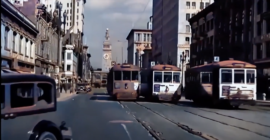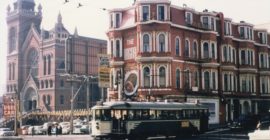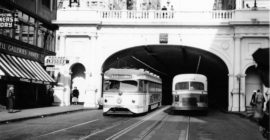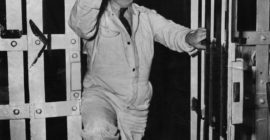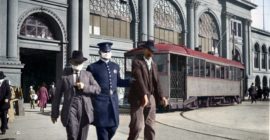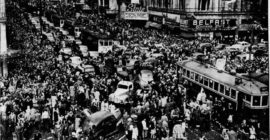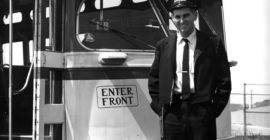December 28, 1912. Fifty thousand San Franciscans gathered at Market and Geary Streets. Was it a presidential visit? No, it was the transit equivalent of a late visit from Santa. It was a new streetcar line.
History Spotlight
Market Street 1932: Wowza!
Market Street, in color, in 1932, when essentially all film was black and white. And not just static, like the photo above, but in full and glorious rumble. Click the video below and prepare to get lost in the past for the next four minutes.
What might have been: Geary
Editors Note: An early version of this article appeared in a past issue of Inside Track, our member magazine with exclusive stories and inside information about Muni’s historic streetcars and cable cars. Click here to become a member and receive it.
What might have been
Editor’s note: A version of this story, by the late Cameron Beach and MSR President Rick Laubscher, appeared in a 2003 issue of Inside Track, our member magazine with exclusive stories and inside information about Muni’s historic streetcars and cable cars. Click here to become a member and receive it.
Ding Dong Daddy: The real story
By Grant Ute, Friends of SF Railway Archive
Two transit pandemics
The Bay Area’s transit agencies are slowly restoring service after deep cutbacks triggered by the shelter-in-place orders imposed in mid-March. Muni, for example, dropped from about 80 lines to just seven, with all rail service, including the historic streetcars and cable cars, suspended. San Franciscans have been ordered to wear masks whenever they’re in public places. (We have history-inspired masks at our store.)
Jubilation — and riots — on Market Street 75 years ago
When President Harry Truman announced the Japanese surrender on August 14, 1945, ending World War II, celebrations erupted around the world. As the primary port of embarkation for US troops headed to the Pacific, San Francisco’s revelry was especially intense.
When the oldest streetcar was new
How old is the oldest electric streetcar in Muni’s historic fleet? So old that it regularly crossed paths with cable cars on Market Street. When “dinkies” (small, single truck streetcars) like preserved Car 578 were new, they were also novel, in that cable cars dominated San Francisco transit and had the exclusive rights to Market Street. The electric cars only saw Market when they crossed it. While they looked like cable cars, they were twice as fast and very high tech for the time, 120 years ago.
Pedal to the metal: “Finding room to run”
We all know that old saying, “They don’t make them like THAT anymore”. With the late Art Curtis, that’s the truth. In his 37-year career with Muni, Art solved all kinds of operational problems as Chief Inspector, but as a “young buck” (his term) operator, he created his share of mischief, too. We’ll be sharing a couple of stories here told by Art himself. This one comes from a 2009 issue of our member magazine, Inside Track. (Join us to get this quarterly magazine with its stories of San Francisco transit history as an exclusive member benefit.)
Pride 1983
Like everyone in San Francisco, we miss the LGBTQ Pride Parade up Market Street this year. At least we can share a look back, framed with pleasure.
Archive: All Posts

